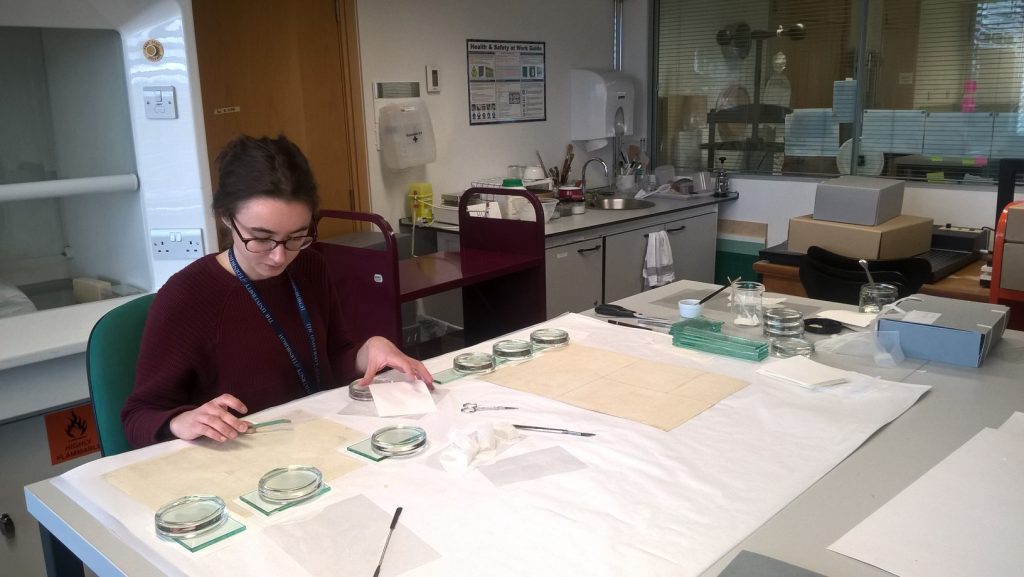In this week’s blog we hear from Clàudia Callau Buxaderas, who is the third in a series of interns to work on the Thomson-Walker collection…
It has been almost eight weeks since I started my internship at the CRC and sadly, this is already my last week working here. After graduating in conservation at the University of Barcelona, I worked as an intern in other institutions and studios around Spain and now I feel extremely lucky to have had the opportunity to work on the Thomson-Walker collection, a large collection of 2700 prints. I am the third conservator to work on this project, which has definitely been an advantage as I was able to start my work on the very first day. I have to thank the two interns before me for that, Samantha Cawson and Victoria Haddock, as they have provided detailed reports to help the future interns on this project. This information has been essential for me to get into the rhythm and way of working in the studio. In the same way, I hope to provide other interns in the future with some new ideas. Given the size the collection, it is always beneficial to find new ways and methods to speed up the work and to get the most of these (very short!) weeks.

Clàudia working in the studio
Eight weeks have passed by incredibly fast as the internship is full of different activities apart from the conservation work, such as visits to other studios and being involved with a range of conservation related activities at the CRC. This is, of course, a great advantage since it allows the intern to make contact with other conservators in Edinburgh, as well as meet different members of the CRC staff. In relation to the last point, I want to highlight the benefits of being involved in this programme from a professional view. Although this is an internship focused mainly on carrying out conservation treatment (specifically on the rehousing of artworks on paper) I can say without a doubt that I have got much more from this experience than just an improvement of my practical abilities as a conservator. As I said, these eight weeks have allowed me to take part in very diverse activities and to improve my understanding of the overall functioning of the CRC from a different perspective. I have worked in other institutions before but I have seldom felt as involved in the whole team work as I have in the CRC. As I see it, the general overview provided by this internship programme is one of its best features and I can conclude that this is one of the most remarkable aspects I have got from my experience here. That has allowed me to know another way of working in a conservation studio, quite different from the ones I have worked before. Here there is a predominance of outreach activities and interaction with other members of the University and the general public. I think this constant, interdepartmental communication is essential to highlight of the importance of preserving rare and unique collections to those outside of conservation.
In regards to my conservation work here, which as you may expect, has taken most of my time, I have followed the treatment proposal written by Samantha in the first internship, with some small modifications. The treatment, which has already been explained in previous posts, is based on adhesive removal with Carboxymethylcellulose (CMC) poultices and making new acid-free folders and boxes in order to rehouse the collection. In almost eight weeks I have conserved approximately 550 prints, so now we have conserved more than half the collection. It is hoped that this work will encourage research, exhibition and further digitisation of the collection.

Prints, during conservation with CMC poultice

Print, during conservation. Pressing under weight

Print, after conservation. Rehoused in a single crease folder

Prints inside single crease folder and four flap folder

Different sized folders used to house the collection
This is the first time I have worked solely on a single project for so long and it has been a very different experience. I didn’t think before starting this programme that working every day on the same basis would be so beneficial to me, but I have learnt so much from it such as time management, independent working, decision making. Now, looking back, I can say this experience has allowed me to gain an essential quality: more confidence in my future work as a conservator. Considering all I have got from my time in the CRC, I would like to conclude by thanking the whole team, and also by underlining the importance of these internships for the enrichment of new professionals.
